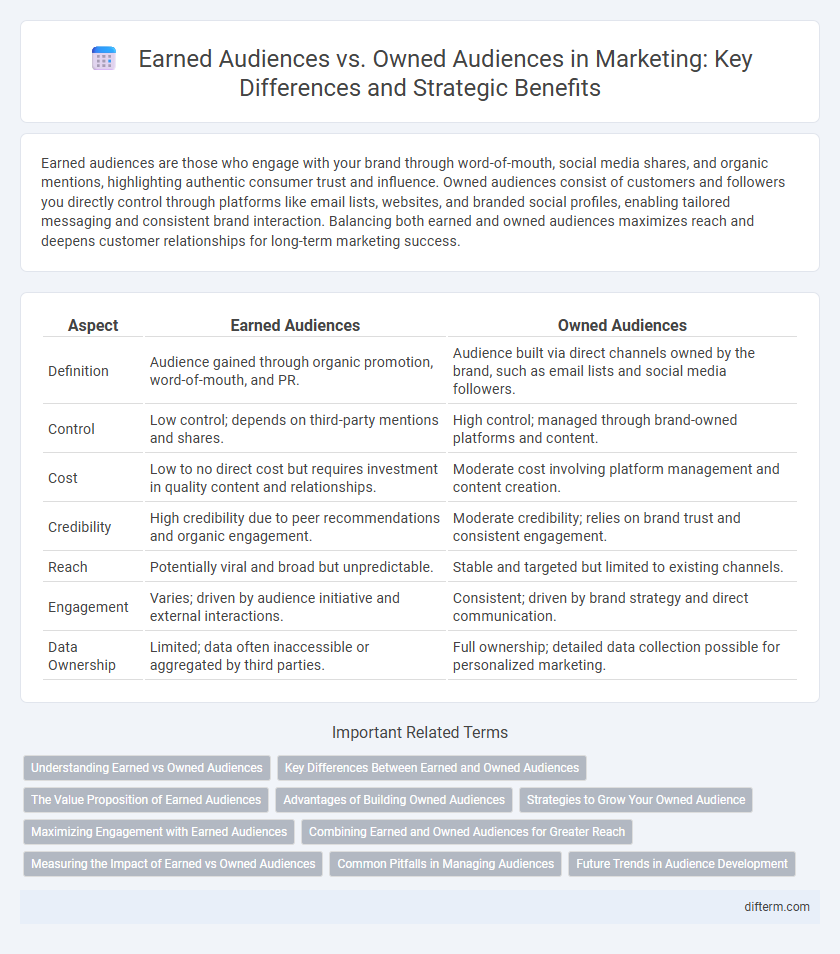Earned audiences are those who engage with your brand through word-of-mouth, social media shares, and organic mentions, highlighting authentic consumer trust and influence. Owned audiences consist of customers and followers you directly control through platforms like email lists, websites, and branded social profiles, enabling tailored messaging and consistent brand interaction. Balancing both earned and owned audiences maximizes reach and deepens customer relationships for long-term marketing success.
Table of Comparison
| Aspect | Earned Audiences | Owned Audiences |
|---|---|---|
| Definition | Audience gained through organic promotion, word-of-mouth, and PR. | Audience built via direct channels owned by the brand, such as email lists and social media followers. |
| Control | Low control; depends on third-party mentions and shares. | High control; managed through brand-owned platforms and content. |
| Cost | Low to no direct cost but requires investment in quality content and relationships. | Moderate cost involving platform management and content creation. |
| Credibility | High credibility due to peer recommendations and organic engagement. | Moderate credibility; relies on brand trust and consistent engagement. |
| Reach | Potentially viral and broad but unpredictable. | Stable and targeted but limited to existing channels. |
| Engagement | Varies; driven by audience initiative and external interactions. | Consistent; driven by brand strategy and direct communication. |
| Data Ownership | Limited; data often inaccessible or aggregated by third parties. | Full ownership; detailed data collection possible for personalized marketing. |
Understanding Earned vs Owned Audiences
Earned audiences consist of customers and followers who engage with a brand through organic methods such as word-of-mouth, reviews, and social media shares, reflecting high trust and authenticity. Owned audiences are those directly controlled by the brand via channels like email lists, websites, and social media pages, allowing personalized communication and targeted marketing. Understanding the distinctions enables marketers to balance organic credibility with strategic content control, maximizing engagement and conversion rates.
Key Differences Between Earned and Owned Audiences
Earned audiences are generated through organic engagement such as shares, reviews, and word-of-mouth, reflecting genuine customer advocacy, while owned audiences consist of contacts directly controlled by the brand via channels like email lists, websites, and social media profiles. Key differences include control, where owned audiences allow brands to tailor messages precisely, and credibility, as earned audiences often carry higher trust and influence due to third-party validation. Measurement also varies: owned audience metrics focus on direct response and loyalty, whereas earned audience metrics emphasize reach, sentiment, and brand advocacy impact.
The Value Proposition of Earned Audiences
Earned audiences generate authentic brand advocacy through customer trust and positive word-of-mouth, significantly enhancing marketing credibility compared to owned audiences. These audiences leverage social proof and organic engagement, driving higher conversion rates and expanding reach without direct advertising costs. Brands benefit from earned media's influence on consumer decision-making, as recommendations from peers are perceived as more trustworthy than owned media promotions.
Advantages of Building Owned Audiences
Building owned audiences offers greater control over customer data, enabling personalized marketing strategies and improved customer relationship management. Owned audiences reduce reliance on third-party platforms, lowering costs and ensuring consistent brand communication. This approach enhances long-term customer loyalty and provides valuable insights for continuous campaign optimization.
Strategies to Grow Your Owned Audience
Strategies to grow your owned audience include creating high-quality, valuable content that encourages repeat visits and engagement on your platforms. Implementing personalized email marketing campaigns and leveraging social media channels to nurture direct relationships strengthens brand loyalty. Consistent optimization of website user experience and using data analytics to tailor content ensures sustained audience growth and retention.
Maximizing Engagement with Earned Audiences
Maximizing engagement with earned audiences leverages authentic endorsements and user-generated content to build trust and credibility organically. These audiences demonstrate higher engagement rates due to their voluntary interaction and advocacy, driving brand awareness and loyalty more effectively than owned channels. Strategies such as social listening, influencer collaborations, and community engagement amplify the reach and impact of earned media, transforming passive viewers into active brand advocates.
Combining Earned and Owned Audiences for Greater Reach
Combining earned and owned audiences enhances marketing reach by leveraging user-generated content and brand-controlled channels simultaneously. Brands amplify engagement through earned media like reviews and shares while maintaining direct communication via owned platforms such as websites and newsletters. This integrated strategy maximizes visibility, builds trust, and drives conversions more effectively than relying on either audience type alone.
Measuring the Impact of Earned vs Owned Audiences
Measuring the impact of earned audiences versus owned audiences involves analyzing engagement metrics such as shares, comments, and reach for earned media, while tracking direct interactions and conversion rates within owned channels like websites and email lists. Earned audiences often drive higher trust and organic growth due to third-party validation, whereas owned audiences provide more controlled and measurable data for ROI assessments. Advanced analytics tools and multi-touch attribution models help marketers accurately attribute value between these audience types for optimized marketing strategies.
Common Pitfalls in Managing Audiences
Marketers often struggle to balance the engagement of earned audiences, driven by third-party endorsements and user-generated content, with the control and personalization offered by owned audiences on proprietary channels like email lists and websites. Common pitfalls include over-reliance on earned audiences without establishing direct communication channels, leading to unpredictable reach, and neglecting to continually nurture owned audiences, causing decreased loyalty and lower lifetime value. Effective audience management requires integrating data analytics to monitor engagement patterns and avoid segmentation errors that dilute messaging relevance.
Future Trends in Audience Development
Future trends in audience development highlight a shift towards integrating earned audiences with owned audiences to maximize engagement and trust. Brands increasingly leverage user-generated content, social media advocacy, and influencer partnerships to amplify earned reach, while expanding proprietary data ecosystems to personalize owned audience experiences. This strategic blending fosters deeper customer loyalty and drives sustainable growth in an evolving digital marketing landscape.
Earned audiences vs owned audiences Infographic

 difterm.com
difterm.com